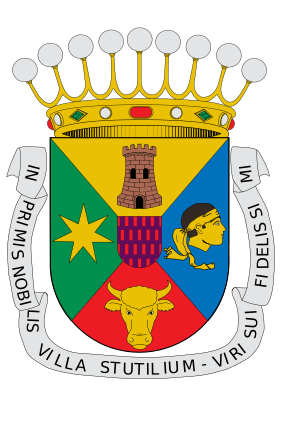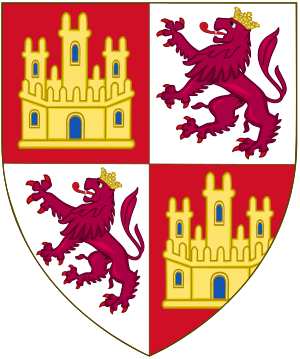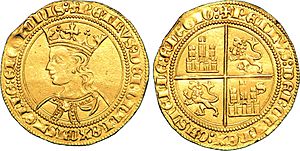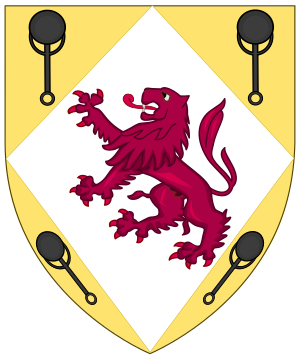Astudillo, Palencia facts for kids
Quick facts for kids
Astudillo
(Statilium, Stutilium, Studellum)
|
||
|---|---|---|
|
Municipality
|
||
 |
||
|
||
| Motto(s):
In primis nobilis Villa Stutilium – Viri sui fidelissimi
|
||
| Country | Spain | |
| Autonomous communities of Spain | Castile and León | |
| Province | Palencia | |
| Comarca | El Cerrato, Tierra de Campos | |
| Area | ||
| • Total | 122.95 km2 (47.47 sq mi) | |
| Elevation | 780 m (2,560 ft) | |
| Population
(2018)
|
||
| • Total | 1,004 | |
| Postal code |
34450
|
|
| Area code(s) | 979 822 | |
| Website | Astudillo Town Council | |
Astudillo is a small town in Spain. It is located in the province of Palencia, which is part of the Castile and León region. Astudillo is about 29 kilometers (18 miles) northeast of the main city of Palencia. In 2018, about 1,004 people lived there. The town covers an area of 122.95 square kilometers (47.47 square miles).
Contents
What's in a Name?
The name Astudillo comes from ancient Roman times. It is believed to be linked to Tito Estatilio Tauro (Titus Statilius Taurus). He was a Roman general whose army operated in this area around 29 BC.
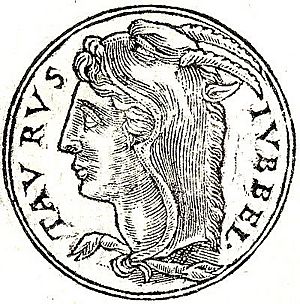
Over many centuries, the name changed. It started as Statilium in Latin during the time of Emperor Augustus. Then it slowly became Stutilium, Studellum, and finally Astudillo in modern Spanish. You can even see the old name STUTILIUM on the town's official Coat of Arms!
Astudillo's Long History
Astudillo has a very old past. People lived here even before Roman times, during the Bronze and Iron Ages. Roman ruins have been found nearby. In the Middle Ages, Astudillo was known for making textiles, like cloth.
In 1995, Astudillo was named a Historic-Artistic Site. This means it has many important old buildings. These include several churches, the Castle of La Mota, and the Convent of Santa Clara.
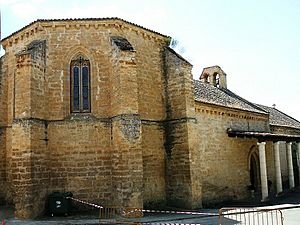
Medieval Times
By the 11th century, Astudillo was an important town. It was surrounded by walls, and you can still see one of its six old gates, the San Martin gate. The other gates, like Revilla and Santa Clara, are gone, but their names are remembered.
In the 12th century, King Alfonso VII gave special rights to the knights of Astudillo. This meant they had many freedoms. Later, in the 13th century, King Ferdinand III of León & Castile made the town even more important. He gave it rights to trade goods, making it a strong center.
Royal Connections
Many queens were linked to Astudillo. In the 12th century, Eleanor of England, Queen of Castile, who was married to King Alfonso VIII of Castile, was the lady of the town. Later, her daughter Berenguela held this title.
In the 14th century, María de Molina was the lady of Astudillo. She stopped a rebel named Juan Núñez de Lara from taking over the town. King Peter of Castile and his partner, María de Padilla, loved Astudillo. They often stayed there, and the king had a palace in the town. Many believe María de Padilla was born in Astudillo. In 1353, María de Padilla started the Convent of Santa Clara, which you can still visit today.
Beatrice, who was the daughter of María de Padilla and King Peter, also became the lady of Astudillo. Later, King Juan II of Castile even set up his royal office in Astudillo for a time.
Population Changes
Astudillo's population has changed a lot over the years. In 1842, there were 451 people. The population grew to over 4,000 in 1857, but then it slowly decreased over time. By 2011, there were 1,106 people, and in 2016, it was 1,004.
How Astudillo Makes Money
The main activities in Astudillo are farming and making food products. The town also produces electricity. You can see several wind farms around the village. There are also solar power systems that turn sunlight into electricity.
Famous People from Astudillo
- Peter I, a King of Castile.
- María de Padilla, who was close to King Peter I.
- Juan de Tapia, a famous fighter.
- César Arconada, a writer and journalist.
- Marcelino García Velasco, a poet and scholar.
- Carlos Bustillo, a journalist.
- Oscar Husillos, an athlete.
Images for kids
See also
 In Spanish: Astudillo para niños
In Spanish: Astudillo para niños



